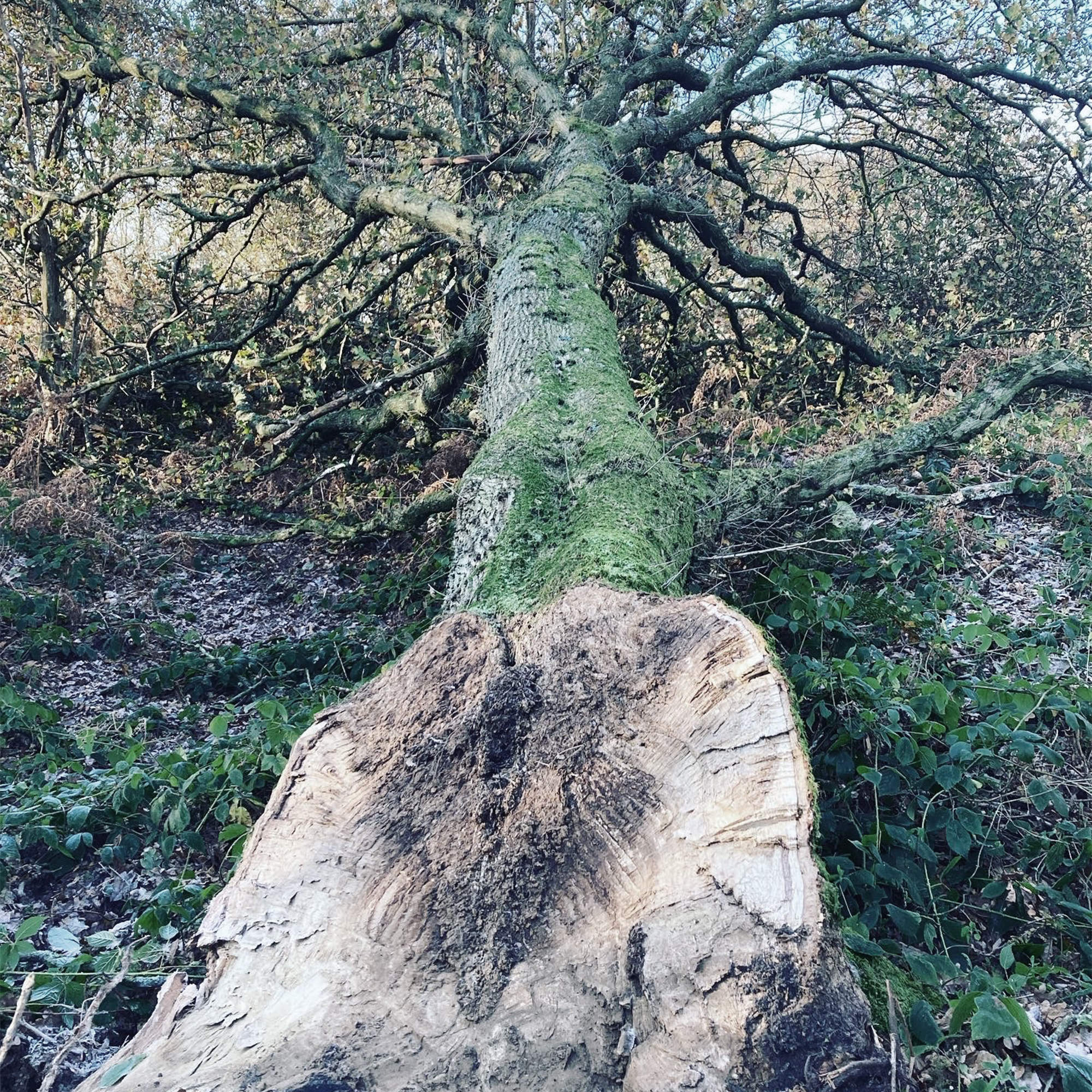The statistics: it has taken 12 hours to smooth the surface, 4 shifts of 3 hours, first with 60, then 80, then 120 grit paper. Dust gathering on me, my hands following the rings as they appeared from beneath the deep scores made by the chainsaw. I could have done all of it with a power planer and a belt sander in about half-an-hour, but it wouldn’t have given me the sense of the tree’s own slow self-making the way this physical labour has. If I hadn’t know the tree it came from I’d be unsure of the species. I can recognise many trees by their leaves, some by their bark and winter silhouettes, but none by the colour and texture of the wood alone. I am not a carpenter. I know that the branch had grown for 32 years. I know which side of it faced the sun. I know that in its eighth year it had a bad summer, starved of warmth or nutrients so that it only grew at a quarter of its normal rate. Tonight I will gaze at it a while longer, run my fingers over its skin-like warmth and feel the faint traces of its rings. I’ll admire my patient labour and the infinitely more patient labour of trees. It’s just a piece of firewood and it should go into the woodburner, but I think I shall probably keep it until I die. Trees should outlast us.
Trees grow by a process of apoptosis, or cellular suicide, similar to most organisms. They are unique in the way that their dead cells are not ejected from the body but instead become the structure around which the organism grows. The living cells are located in a thin layer between bark and xylem. As a cell dies its walls harden and thicken with lignin deposits while its centre becomes hollow to allow the transportation of water and nutrients. The xylem increases circumferentially each growing season and goes dormant in winter, producing the rings that we see when a tree is felled. In northern climates the cells on the sun-exposed side of the tree grow faster than on the cool side. Tree rings become more asymmetrical the further north the tree is situated. The inner ring of this stump is only a few centimetres from the bark on one side and is over 20 centimetres from the other.
The artist Bryan Nash Gill spent years creating relief prints from the cross-sections of trees he found in his Connecticut farming neighborhood, collecting his specimens from local gardens, lumber yards and road verges. The oldest tree he ever printed from was a fallen telegraph pole. The process he used involved chainsaw and plane, followed by hours of sanding with progressively finer grade papers. He then used a blowtorch to burn away the softer summer wood and enhance the pattern of the rings in relief. Finally he sealed the wood and started to print from it. He used many different species of softwood and hardwood, including ash, hemlock, locust and spruce. The prints from his series “Hemlock 82” are almost impossibly rich images, deeply textured with an undulating pattern made of lines that barely resemble tree rings, but are more akin to terrain maps of steep hills. The shakes in the wood could easily be the paths of rivers traced from source to sea.
The log I’ve polished is just one from the pile we use to heat our house. We start adding to it in mid-summer and by the time we light the woodburner we’ve filled half the garage to the ceiling, enough to last the whole winter. I like the work of stacking, fitting each piece tightly so that it doesn’t roll or fall. I pick out logs with straight grain that can be split cleanly for kindling. I like the way they cleave easily down their length and land with a clink like broken terracotta. I carry three armfuls of logs into the house every evening and drop them into the big basket. I like the cold mornings, sitting in front of the burner having just fanned the embers from the previous day into life, the air in the room slowly warming, the water in the back-boiler starting to fizz. It’s good, as someone with a sit-down job, to be required to complete this physical routine every day for almost half the year.
The log came from an ash tree located in a field bordering our house. It blew down in a storm last winter and in a month or so the old farmer, a man with a life of slow labour behind him, cut it into hundreds of pieces and piled them up in his yard. The tree will keep him warm for all the winters he’s got left, so he lets me take some of the logs in exchange for me occasionally fixing his laptop or mobile phone. I’ve been taking pieces out of the pile that have split and weathered in interesting ways. It was Bryan Nash Gill’s ambition to make a series of prints of all the sections of a whole tree, from its roots and trunk to its thinnest branches. This ash would have been the perfect subject for him.
I believe that art doesn’t come out of artists. It is discovered within the medium in which they are working. It is something long hidden which, through patient labour, they manage to reveal. The medium can be anything, paint, stone, wood or breath. In the process something is transferred back to the artist from the subject. A ring grows inside. Slowly, with long practice, they become eccentric. This transference is a process similar to hard labour. When I lived in the Black Country I remember finding a book of old photographs of local metalworkers. These men had worked for decades shaping and finishing steel with hand files, a slow and physically demanding process which had deformed them over time. They had bent backs, one protruding shoulder and the arm they favoured to work the file bulged with muscle while the other was emaciated. Artists, in old age, often reveal their practices in their bodies, in the way they move and speak, the way they gaze. Samuel Beckett’s wild seagull eyes that stared for decades over a cliff edge into the abyss. Georgia O’Keefe’s face and hands rutted, crenulated, as if she had been shaped by the same processes as the New Mexico desert she had been painting for half her long life.
Like trees we grow towards the light, but we’re always half in shadow. Over time we twist out of shape. There are asymmetrical rings radiating from our hearts. The latest ring which has formed inside me is darker than the rest. I imagine it to be the colour of blood ochre. It contains the death of my father and a family friend, a two month suicide watch, the stick that lodged 1mm from my labrador’s carotid artery, and a series of minor crises that have only recently started to abate. I was stretched in so many directions last year that I’ve started to take on a new shape. It looks faintly tree-like.
I don’t know what I’ll look like when I reach old age. I’m hoping for big knuckles, fingers that can’t straighten, cords in my arms, skin like walnut veneer. Perhaps a few tufts of grey moss will grow somewhere on me. I’ll be out of shape, showing the traces of a life bent towards something. I’ll leave behind a workshop filled with well-used tools and an assortment of collected timber, not made into anything practical, but finished to reveal their own inner making.

